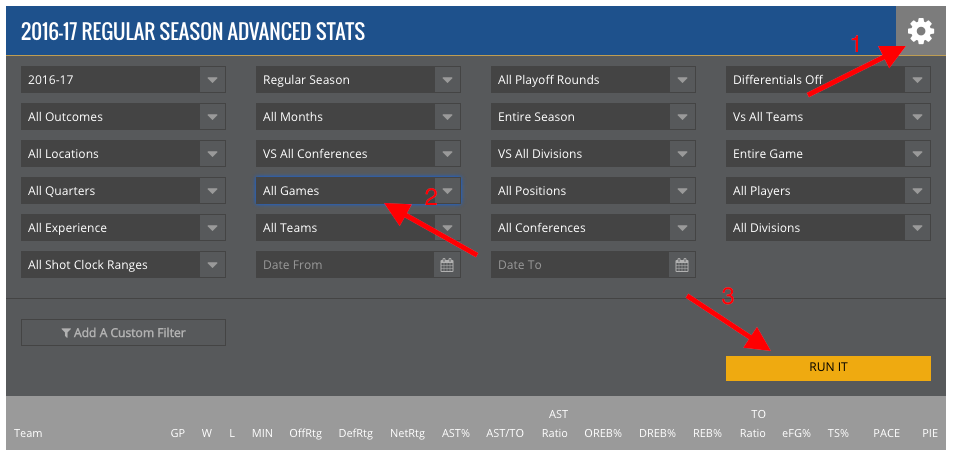This article is part of our Numbers Game series.
Defensive rating is an easy catchall for the overall quality of a team's defense. It is a measure of how many points an opposing team averages per possession. It tracks the direct objective of a defense – to stop the other team from scoring. Since scoring is such a major part of the fantasy game, defensive rating is one of the advanced stats most used by analysts and managers alike.
When analyzing the importance of pace for last week's column, I found that the results were most reliable if a team's defense – according to defensive rating – was average. This led me to consider, are the same teams average all the time? Can I check once now, and then just remember who the best and worst are? Do team defenses perform consistently over the course of the season?
How Did You Figure That Out?
I started by breaking down the 2015-16 season into the five months completely contained within the NBA season – November, December, January, February and March. This allowed me to ignore the first couple games of the season, allowing teams to settle into some sort of rhythm, as well as the late season games that can be heavily impacted tanking teams and players resting for the playoffs.
Next, I normalized the data – we are interested in how good teams are compared to one another, not compared to some arbitrary numeric benchmark. The normalized data showed how a team compared to the rest of the
Defensive rating is an easy catchall for the overall quality of a team's defense. It is a measure of how many points an opposing team averages per possession. It tracks the direct objective of a defense – to stop the other team from scoring. Since scoring is such a major part of the fantasy game, defensive rating is one of the advanced stats most used by analysts and managers alike.
When analyzing the importance of pace for last week's column, I found that the results were most reliable if a team's defense – according to defensive rating – was average. This led me to consider, are the same teams average all the time? Can I check once now, and then just remember who the best and worst are? Do team defenses perform consistently over the course of the season?
How Did You Figure That Out?
I started by breaking down the 2015-16 season into the five months completely contained within the NBA season – November, December, January, February and March. This allowed me to ignore the first couple games of the season, allowing teams to settle into some sort of rhythm, as well as the late season games that can be heavily impacted tanking teams and players resting for the playoffs.
Next, I normalized the data – we are interested in how good teams are compared to one another, not compared to some arbitrary numeric benchmark. The normalized data showed how a team compared to the rest of the league for each individual month. For example, if the league-wide average defensive rating changed, the best team would still have a score around 2, and a mediocre team around 0.
Finally, I compared each team's results from month to month – both with the normalized data, as well as with the original raw figures, as a way of double-checking my results.
Did You Need To Normalize The Data, Or Are You Just A Math Nerd Adding Extra Steps For Your Own Enjoyment?
I can't deny the latter charge.
But while I was crunching the numbers, I stumbled across an interesting – and unexpected – trend. As the season wore on, the league-wide average defensive rating was increasing. Since this measures opponent points per possession, this means that defenses were getting progressively worse.
The trend was consistent – league wide, defenses allowed one extra per point per 100 possessions per month. The mathematical strength of the relationship was very high.
Quick aside for Roto league managers: if there is fantasy value in this finding, it is this – if possible, target players who play more games later in the season. The Bucks, Cavaliers and the Wizards play the most games after the All-Star break, followed by the 76ers, Clippers, Hawks, Hornets, Mavericks, Nets, Nuggets, Spurs, Trail Blazers and Warriors. As a caveat, since I was not looking for this discovery, I have not yet thoroughly checked its strength in previous seasons, though the strength of the relationship says that it is highly unlikely to be a coincidence.
I normalized the data since I did not want this startling development to negatively impact my findings.
So, What Did You Find?
Teams moved through the rankings all season. Some movements told an easy story – the Hawks started mediocre, improved steadily as the season went along, and ended as one of the elite defenses in the league. The Jazz told a similar story of mostly steady improvement, while the Nets were in steady decline.
Other teams, however, were simply inconsistent. The Wizards for example, bounced around league average all season, but not by staying in the middle of the pack. In one month, they rated the seventh worst defense in the league – the next month, the sixth best. The overwhelming majority of teams showed this type, if not this degree, of inconsistent movement up and down the rankings throughout the season.
How Much Difference Was There Month To Month?
A lot.
The most consistent team in the league ranged from having the sixth-worst defense to having the 19th-worst (the same thing as the 12th best). The second-most consistent team fluctuated between being the fourth best defense and 15th best in back-to-back months – one month they were one of the toughest teams in the league, the next they were the very definition of average.
The team that experienced the most fluctuation spent one month as the third best defense in the league, and another as the 26th best (the same thing as fifth worst).
Almost every team fluctuated by more than 10 spots in the rankings, which is enough to move teams from the best third of the league to the worst third.
Breaking the league into three equal sized tiers – 10 best defenses, 10 average and 10 worst – only two teams spent the entire season entrenched within a single tier. One was the Lakers, who fluctuated between almost-normal bad and the worst-month-of-any-team-in-the-season bad. The other was the Spurs, who similarly fluctuated between very good and best-month-of-any-team-in-the-season good. As has come up in previous columns, All Hail King Popovich.
How Can We Use This Info?
You have to monitor defensive rating steadily throughout the season. No matter what patterns you see emerging, you have to continue to check to make informed decisions. At the beginning of last season, there was no indication that the Hawks would become a dangerous fantasy opponent, nor that the Nets would become a favorable one. Yet, in tight weekly matchups, and even possibly some hard-fought season-long Roto leagues, the difference between the two teams could have decided fantasy championships.
Furthermore, it is not enough to merely check the season-long averages. Make sure to filter the data so that you are only looking at the most recent games – I prefer to set it to show the last 10 games worth of data. Showing season-long data may lead you to assume the exact opposite of the most recent trends – multiple teams jumped from the top third of the league one month to the bottom third of the league the next.
This information can all be found and filtered on NBA.com's stats site :

Once there, follow these steps:
1. Click the gear in the upper right corner of the data table.
2. Click the "All Games" pull-down, and set it to however many recent games you want to consider.
3. I like to use the last 10, but anything more than five or should give you meaningful data. Any fewer, and you risk data that is heavily swayed by a particularly tough, or particularly easy, patch in the schedule.
4. Click the big yellow "Run It" button.
5. Remember, high defensive rating numbers means a bad defense (since they allow such a high number of points), which makes a team a good target for fantasy. Low defensive ratings means a good defense (since they allow few points), and a bad opponent for fantasy.
Defensive rating is just one piece of the fantasy puzzle, but it can make a difference in determining who to play, who to bench, and even what waiver wire players to target – especially if you are in a league that allows for streaming. Don't assume you know which teams are good defenses and which are bad, since all teams experienced significant fluctuation throughout the season.
Well, except for the Spurs. The Spurs are always good.
Do you have a topic to investigate? Mention it in the comments below.









